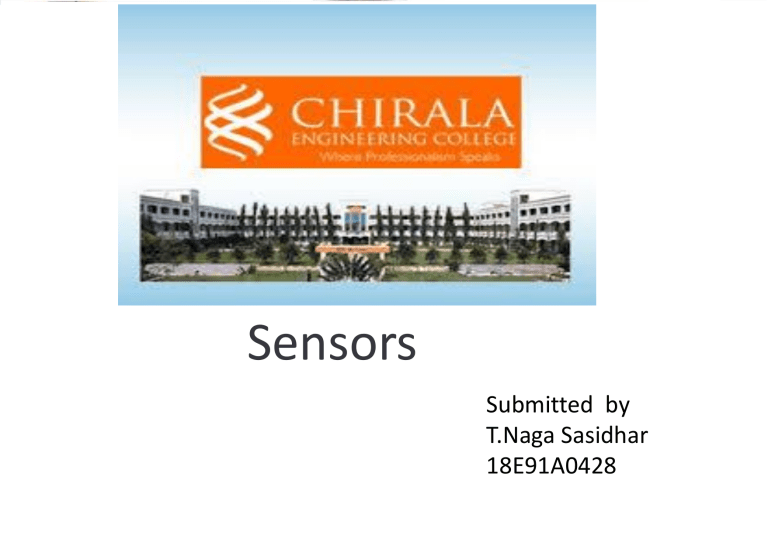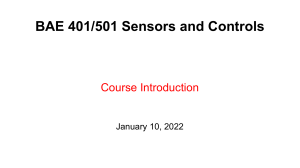
Sensors Submitted by T.Naga Sasidhar 18E91A0428 CONTEN TS Defining sensors and transducers Classifying sensors Some important sensor characteristics Some important physical principles used in sensing. Advantages of electrical transducers. (sensors) Sensors and transducers Sensor is a device that receives a stimulus and outputs an electrical signal Upon a stimulus (the quantity, property or the condition that is being sensed), sensors generate electrical output. Transducer is device that converts one form of energy to another form of energy. All sensors are transducers but all the transducers are not necessarily sensors. We want the stimulus to be converted to electrical domain rather than any other domain. (mechanical) Sensors and transducers (Contd…) A sensor can comprises of several transducers •Example A chemical sensor can comprise of a transducer that converts the chemical energy to heat and another transducer that converts heat to electrical signal. Stimulus Chemical reaction, Output electrical signal The direct sensor is a common part in every sensor and it make use of different physical principals like hall effect, photoeffect etc. Sensors and transducers (Contd…) Thus a sensor can be a direct sensor (one element, single transducer) or a complex sensor (several elements, several transducers) The stimulus for sensors can be any conceivable physical or chemical characteristic such as Light flux Temperature Pressure Humidity Vibration Position Displacement … Classifying sensors Different sensor classification criteria are available. Passive sensors Generates the output by the applied stimulus itself. No need additional energy source. E.g. Thermocouple, piezo electric sensors Sensors Active sensors In addition to the stimulus there is a power source applied to the sensor. The stimulus is modulated in the excitation signal (external energy) and given as the output. E.g. Temperature sensitive resistors (Thermistors), Classifying sensors (Contd…) Depending on the reference selected Absolute sensors Sense the stimulus with reference to an absolute physical scale which is independent from the measurement conditions E.g. Thermistor K scale Sensors Relative sensors Produce the output to the stimulus with respect to a special case of the stimulus. Not directly connected with an absolute physical scale. E.g. Thermocouple Sensor characteristics We will look at the sensor as a black box and consider some of its characteristics that characterize the stimulus, output and the transition. These sensor characteristics are significant when selecting a sensor to a particular application. Some may not be applicable for all type of sensors. Frequency response and bandwidth The range of frequencies within which thesensor can be effectively used is called the bandwidth. Usually defined as 3dB bandwidth. That is the frequency range within which the output lies between the (half of the maximumoutput) and the (maximum output). Sensor characteristics - Sensitivity Sensitivity refers to the ability of the sensor to produce a change in output for a unit change in the stimulus. Defined as Change of output/Change of input Unit depends on the actual sensor which is under interest. Static error –The difference between the measured and the actual values. Error_Perc entage Error Act ual_Value 100 % Sensor characteristics (Contd…) Full Scale Input (Span) The dynamic range of stimuli that the sensor can sense is called the span. It gives the highest possible input that can be sensed with an acceptable level of accuracy. Sometimes the span is given by decibels. (dB) Eg: Thermistor from -900C to 1300C Thermocouple from -1850C to 17000C Capacitive Proximity Sensor - from 1mm to 5cm Sensor characteristics (Contd…) Full Scale Output (FSO) This is the algebraic difference between the electrical output signals obtained with the highest possible input and the lowest possible input respectively. Eg: 0V 5V for temperature sensor1 4-20mA for temperature sensor2 0-24V for load cell1 Sensor characteristics (Contd…) Accuracy Tells how inaccurate the sensor is !!! Measured as the highest deviation of a value indicated by the sensor, from the actual (true) value at that input. The accuracy (inaccuracy) is expressed as, Directly in terms of the measured output value As a percentage of the input full scale (span) In terms of the output signal E.g. A piezo-resistive pressure sensor having 100 kPa span and 10Ω full scale output, has an accuracy of either +-0.5%, + 500Pa or +-0.05Ω Sensor characteristics (Contd…) Hysteresis Output of some sensors not only depend on the present stimuli but also depend on the past inputs. (history). Because of this the output can be different for the same value of input when the measurement is taken for increasing input and decreasing input separately. Physical and structural changes in materials and friction can cause the hysteresis Sensor characteristics (Contd…) Saturation – At some levels of the input stimuli the output will no longer be responsive to the input. Then further increase in stimuli will not produce considerable output . After the linear span the sensor exhibits span end nonlinearity or saturation. Sensor characteristics (Contd…) Repeatability Ability of the sensor to produce the same output in different measurement trials under the same conditions. Repeatability error is the inability to do so. Repeatability error can be caused by build up charges, material plasticity, thermal noise. Dead band Tells the insensitivity of a sensor over a given range of input signal. Sensor characteristics (Contd…) Resolution The smallest change in the stimuli that is capable of resulting a measurable output difference. Output impedance Plays an important role when interfacing the sensors with other circuitry. Sensor having voltage output Sensor having current output Sensor characteristics (Contd…) Reliability Ability of a sensor to perform its function under stated conditions for a given period of time. Usually this figure is expressed as a probability that the sensor will function properly with out a failure over a given period of time. But not commonly specified by the sensor manufacturers. Can be expressed as a MTBF (Mean Time Between Failure) figure. Some physical principles used for sensing Capacitance Inductance/Magnetism – Resistance – Temperature sensitivity Strain sensitivity Moisture sensitivity Piezoelectric effect Pyroelectric effect Hall effect Seebeck effect Sound waves Heat transfer - Advantages of electrical transducers (sensors) Electrical amplification and attenuation is possible Effect of friction is minimized. Mass inertia effects are minimized. Output can be indicated and recorded remotely. Output can be modified or conditioned in order to meet the requirement imposed by the other control elements. The electrical/electronics based systems can be controlled with a small power. Electrical signal can be easily transmitted for further manipulation.



